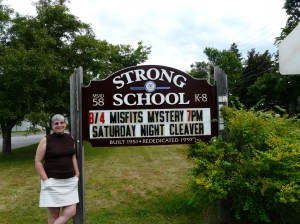PHILLIPS – Felecia Pease is modest about her two schools’ accolades.
Pease said she does not have a magic formula to explain why she and her staff and communities receive regular awards for excellence.
“Each school is fortunate to have teachers, parents and community that are vested in their children,” she said.
The Strong Elementary School was one of three in Maine named a 2005 No Child Left Behind-Blue Ribbon School, and one of 295 nationwide that was awarded the honor. Students performed in the top 10 percent in state assessment scores in reading and math.
Last year, SAD 58 Superintendent Brenda Stevens announced that both Strong and Phillips Elementary Schools had met the challenging Maine Department of Education’s Adequate Yearly Progress standards. Pease became principal of both when finances forced administrative cuts.
At Thursday night’s school board meeting, Stevens announced to the audience that the Strong school received high marks as one of the finalists in a study of the state’s most efficient schools.
The Maine Education Policy Research Institute, the Center for Education Policy, Applied Research and Evaluation at the University of Southern Maine, and the Nellie Mae Education Foundation conduct a joint multiyear study of Maine’s K-12 education system. School efficiency profiles were developed for 524 of the 664 Maine public K-12 schools. The final studies through 2011 were done in 16 schools, including grades kindergarten through 12.
Finalists on the More Efficient Schools list were varied, according to the report. Some schools were larger and some smaller. The ranges of low income found among more efficient schools tend to mirror the ranges in low income found among all elementary and middle schools. In high schools, the low income levels found among More Efficient schools did not mirror the state average. High school graduation rates for More Efficient schools are approximately 10 percent higher than the state average, while these schools spend anywhere from $166 to $1,023 less per student than state averages.
Continuity is the key, Pease said, because students need to understand what’s expected of them.
“When students arrive, they know the routine and what will happen next,” she said. “Children need to know what the expected outcomes are.”
Recognizing students for their accomplishments in Strong and Phillips schools makes everyone committed to a successful outcome, she said.
“While I attended schools with separated grades, I’ve always worked in schools with K-8,” she said. “Students have connections in K-8 schools that don’t necessarily happen in different configured buildings.”
She and her staff consider themselves part of the “school family.” She participates in a community play performed each August, and she enjoys the silliness and spontaneity of the practices and the dedication of the families involved each year.
“More times than not, we get to watch children grow from age 5 through early teens,” she said. “We are lucky to really get to know children, and they us.”
The awards she and her schools receive are part of the shared appreciation and recognition of that closeness and support from the district’s communities.
“We encourage children to believe in themselves just as we believe in them,” she said. “Every day is a new day and a chance to improve.”
On the Web
For more information about the Efficient Schools study, visit www.usm.maine.edu/cepare.

Comments are no longer available on this story